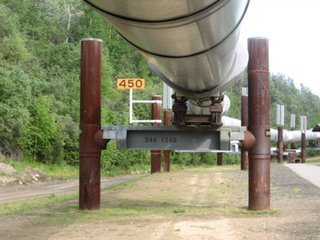Sunday, June 17, 2007
Alaska Pipeline, Environmental Issues

The basic problem facing engineers was that there was no technology yet devised that could deal with permafrost, bitterly cold temperatures and the extreme terrain that comprises AK. In addition, environmental and Native groups all lined up to add their concerns to the known environmental concerns.
Eventually all were addressed. The Arab oil embargo of 1973-74 drove home the fact that the United States� dependence on foreign oil was an exposure we did not need. Alaskan native claims were resolved with the 1971 Alaska Native Claims Settlement Act. The Trans Alaska Pipeline Authority At was passed in November of 1973. It cleared the way for construction to begin.
Alaska�s permafrost underlays nearly 600 miles of the pipeline route. Oil comes out of the ground between 156-178 degrees F. Known methods of burying pipeline would have resulted in thawed permafrost which in turn would surround the buried pipe with a soupy silt/water mess. The solution: Move the pipeline above ground with H-shaped vertical supports (see photo at top of this post). On top of these H structures, you will notice aluminum fins. The fins act as a cooling system that pulls excess heat from the permafrost layer and radiates it into the air. This complex yet complete solution represented the first time a pipeline had been built above ground.
The H supports went in slowly, in fact so slowly the pipeline completion date was expected to last until 2010. However, again ingenuity raised its head. By changing the type of materials and processes used, the construction and installation of the supports rapidly increased. Eventually 78,000 supports were placed into service and the 2010 completion date was no longer an issue. These supports hold 420 miles of pipe above ground.
Photos often show the zigzag configuration of the pipeline. This unique design accommodates seismic activity (earthquakes) and the extreme temperature changes along the pipeline route. In addition, in the middle of the H supports, just above the cross-section of the H, is an approximately 4' bar that can move from one side of the H to the other. This horixontal flexibility also lets the pipe flex during an earthquake. Hence, damage is minimized.
A total of 380 miles of pipeline was buried underground. The depth ranged from 3-12 feet, depending on soil conditions. For pipeline buried in avalanche-prone areas, the underground components were refrigerated to protect the permafrost.
Labels: Energy









